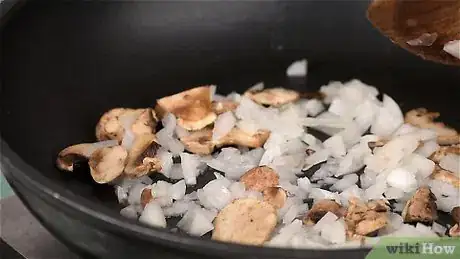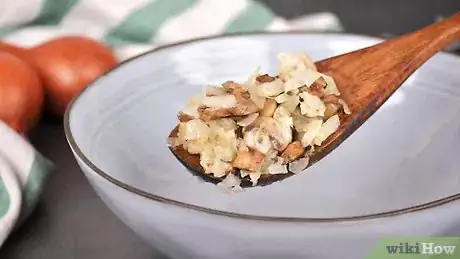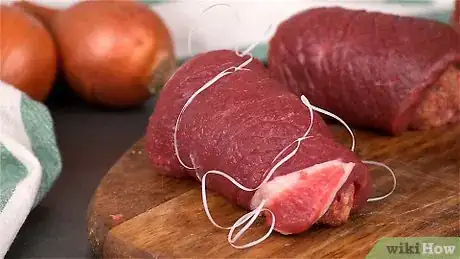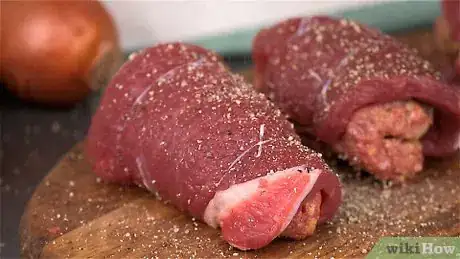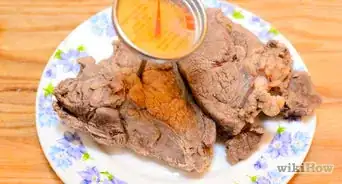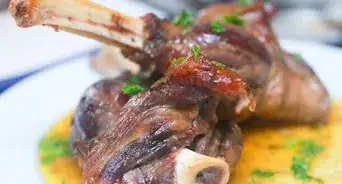This article was co-authored by wikiHow staff writer, Janice Tieperman. Janice is a professional and creative writer who has worked at wikiHow since 2019. With both a B.A. and M.A. in English from East Stroudsburg University, she has a passion for writing a wide variety of content for anyone and everyone. In her free time, you can find her working on a new crochet pattern, listening to true crime podcasts, or tackling a new creative writing project.
There are 8 references cited in this article, which can be found at the bottom of the page.
The wikiHow Culinary Team also followed the article's instructions and verified that they work.
This article has been viewed 112,636 times.
Learn more...
Beef olives don’t actually have olives in them—instead, they get their name from their rolled-up appearance. This dish has two main parts: a savory, mincemeat filling that’s surrounded by a thin piece of steak. While this meal is especially popular in the UK, anyone can make this savory meal with the right ingredients.
Ingredients
- 2 US tbsp (30 mL) of vegetable oil
- 1 shallot, finely chopped
- 2 US tbsp (15.5g) of chopped mushrooms
- 4½ oz (120 g) of beef mince (ground beef)
- 2 tbsp (15 g) of breadcrumbs
- 1 US tbsp (15 mL) of Dijon mustard
Steak
- Two 3 oz (80 g) slices of rump beef steak (or silverside)
- 2 onions, finely chopped
- 1 US tbsp (8.5 g) of plain flour
- 3½ fl oz (100 mL) of dark ale
- 9 fl oz (250 mL) of beef stock
Makes 2 servings
Steps
Making the Filling
-
1Fry the chopped mushrooms and shallots in oil until they’re soft. Grease a skillet with 1 US tbsp (15 mL) of vegetable oil and set your stovetop to high heat. Toss 1 finely chopped shallot and 2 US tbsp (15.5 g) of chopped mushrooms into the pan. Shift these around a bit with a spatula as you fry them so they don't burn or stick.[1]
- It should only take a few minutes for everything to brown.
-
2Transfer the fried veggies to a separate dish so they can cool. Scoop the cooked mushrooms and shallots out of the hot skillet with a slotted spoon and move them into a clean bowl. Give the filling a few minutes to cool down before mixing it with the other ingredients.[2]Advertisement
-
Video Player is loading.
This is a modal window.
The media could not be loaded, either because the server or network failed or because the format is not supported.3Stir the minced beef, mustard, and breadcrumbs into the fried veggies. Knead 4½ oz (120 g) of mince beef in with the mushrooms and shallots. Then, add 1 US tbsp (15 mL) of Dijon mustard and 2 tbsp (15 g) of regular breadcrumbs. Keep kneading and folding the ingredients together until they're well-mixed and the texture is consistent.[3]- Try pork instead of beef if you’d like to change things up.[4]
-
Video Player is loading.
This is a modal window.
The media could not be loaded, either because the server or network failed or because the format is not supported.4Mold the filling into 2 sausage-shaped rolls that are 1 in (2.5 cm) thick. Divide the mincemeat filling into 2 even piles. Using your hands, roll the meat mixture into a sausage shape. Make these sausages about the same height as the strip steak, so your “olive” isn’t overstuffed.[5]
Assembling the Beef Olives
-
1Place the filling “sausages” on top of the beef steaks. Arrange each sausage along the left or right side of your strip steak. These strip steaks will form the “olive,” while the filling will form the “pit.”[6]
- Get steaks that are about 0.4 in (1 cm) thick. If your steak is too thick, pound it with a meat hammer or rolling pin ahead of time to flatten it out.[7]
-
Video Player is loading.
This is a modal window.
The media could not be loaded, either because the server or network failed or because the format is not supported.2Roll the steak around the filling to create a cylinder shape. Hold both ends of the steak with your hands and roll it forward, surrounding the filling with the steak as you go. Continue rolling the steak forward until it’s cylinder-shaped.[8] -
3Tie both ends of the beef olives with string to secure them. Pinch both ends of the rolled-up beef olive so the meat and filling don’t unravel. Then, cut 2 small sections of kitchen string and tie them around both ends of the beef olive. This keeps the meat from coming apart while it cooks.[9]
- Use toothpicks in addition to the string if you want to make everything extra secure.[10]
Frying and Simmering the Dish
-
1Sprinkle the raw beef olives with salt and pepper. Grab a pinch of salt and coat the steak surrounding the beef olives. Then, sprinkle a pinch of pepper on top of the meat as well.[11]
-
Video Player is loading.
This is a modal window.
The media could not be loaded, either because the server or network failed or because the format is not supported.2Fry the beef olives for 2-3 minutes until they’re golden brown.[12] Grease your skillet with 1 US tbsp (15 mL) of vegetable oil and set the burner to high heat. Place the beef olives in the greased skillet and fry them, shifting occasionally with a spatula, until all of the sides look golden-brown.[13]- Feel free to cook the beef olives in batches if your skillet is pretty small.
-
Video Player is loading.
This is a modal window.
The media could not be loaded, either because the server or network failed or because the format is not supported.3Add chopped onions to the skillet and brown them in the oil. Chop up 2 onions and toss them into the pan along with the beef olives. Stir the onion pieces around until they look nice and golden.[14] -
Video Player is loading.
This is a modal window.
The media could not be loaded, either because the server or network failed or because the format is not supported.4Pour in the beer and drop a spoonful of flour into the pan. Pour 3½ fl oz (100 mL) of dark beer into the skillet to create a base for your sauce. Then, stir in 1 US tbsp (8.5 g) of plain flour to help thicken the sauce as it cooks.[15]- Any kind of dark beer or ale will work for this.
-
Video Player is loading.
This is a modal window.
The media could not be loaded, either because the server or network failed or because the format is not supported.5Simmer the mixture for 5 minutes and pour in the beef stock. Set your stovetop to a lower heat, letting the beef olives simmer with the onions and beer base. After 5 minutes, add in 9 fl oz (250 mL) of beef stock to round out your sauce/gravy. -
Video Player is loading.
This is a modal window.
The media could not be loaded, either because the server or network failed or because the format is not supported.6Cover the mixture and let it simmer for a half hour. Place a lid on top of your skillet and set a timer for 30 minutes. Simmer the dish for 30 minutes or so. At this point, dish up your beef olives and enjoy![16]- This dish tastes great with roasted leeks and carrots.
- Refrigerate any leftovers and enjoy them within 4 days. Transfer any leftover beef olives and gravy to an airtight container. When enjoying your beef olives again, reheat the dish until it’s at least 165 °F (74 °C).[17]
Things You’ll Need
- Skillet
- Spoon
- Bowl
- Kitchen string
- Spatula
- Toothpicks (optional)
References
- ↑ https://www.bbc.co.uk/food/recipes/beef_olives_and_onion_11851
- ↑ https://www.bbc.co.uk/food/recipes/beef_olives_and_onion_11851
- ↑ https://www.bbc.co.uk/food/recipes/beef_olives_and_onion_11851
- ↑ http://allrecipes.com.au/recipe/6015/traditional-beef-olives.aspx
- ↑ https://www.bbc.co.uk/food/recipes/beef_olives_and_onion_11851
- ↑ https://www.bbc.co.uk/food/recipes/beef_olives_and_onion_11851
- ↑ https://www.bbcgoodfood.com/user/232728/recipe/beef-olives
- ↑ https://www.saveur.com/article/Recipes/Beef-Olives/
- ↑ https://www.bbc.co.uk/food/recipes/beef_olives_and_onion_11851
- ↑ https://www.taste.com.au/recipes/beef-olives/f0f50bdf-a399-4d45-86b8-5b3267b2e6a3
- ↑ https://www.bbc.co.uk/food/recipes/beef_olives_and_onion_11851
- ↑ https://www.taste.com.au/recipes/beef-olives/f0f50bdf-a399-4d45-86b8-5b3267b2e6a3
- ↑ https://www.bbcgoodfood.com/user/232728/recipe/beef-olives
- ↑ https://www.bbc.co.uk/food/recipes/beef_olives_and_onion_11851
- ↑ https://www.bbc.co.uk/food/recipes/beef_olives_and_onion_11851
- ↑ https://www.bbc.co.uk/food/recipes/beef_olives_and_onion_11851
- ↑ https://www.fsis.usda.gov/wps/portal/fsis/topics/food-safety-education/get-answers/food-safety-fact-sheets/safe-food-handling/keep-food-safe-food-safety-basics/ct_index%20
- ↑ https://www.thebuffalofarm.co.uk/recipes/beef-olives-cooking-instructions
